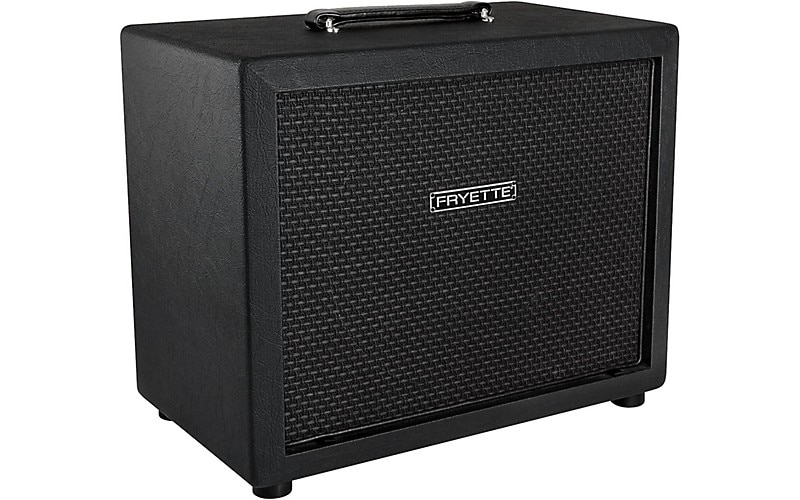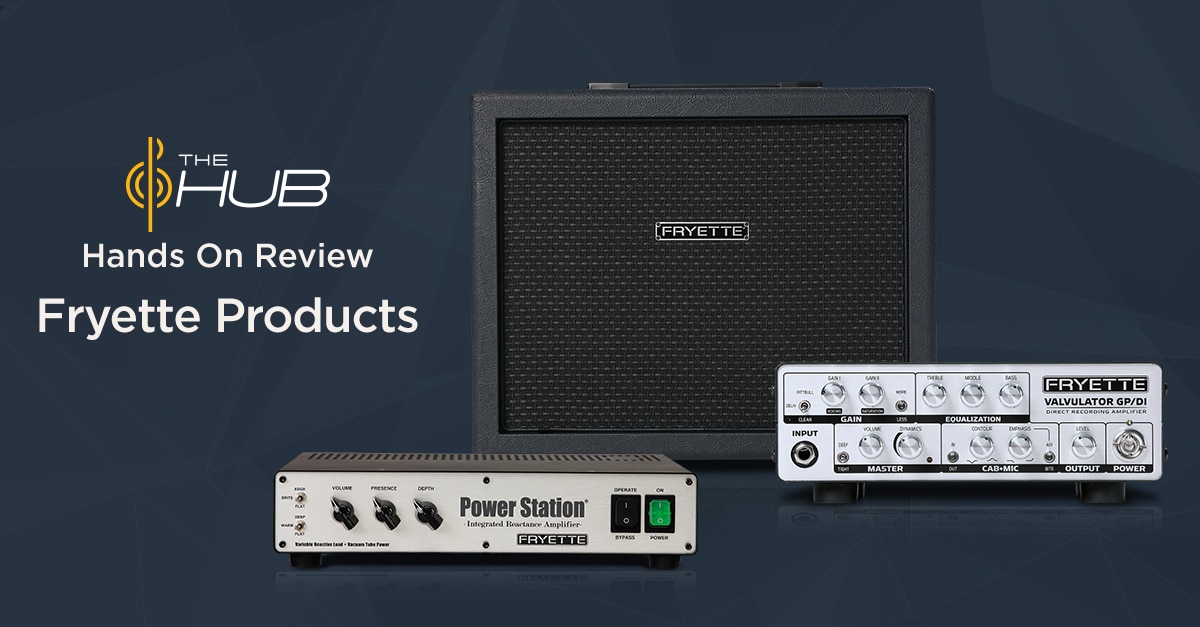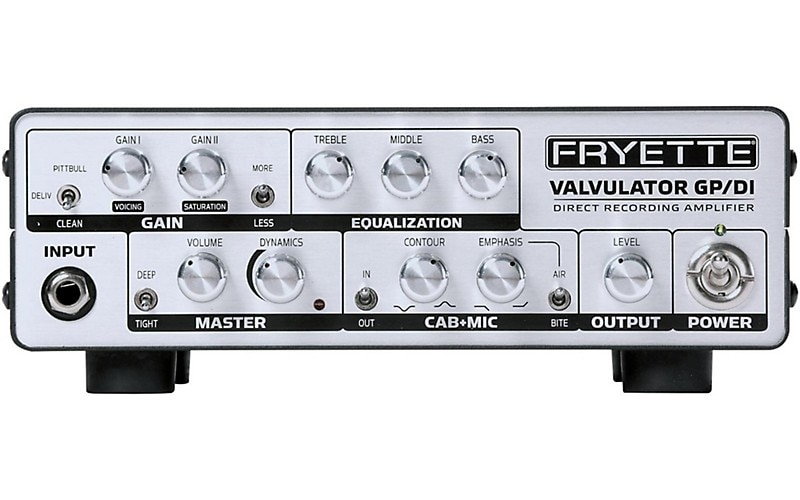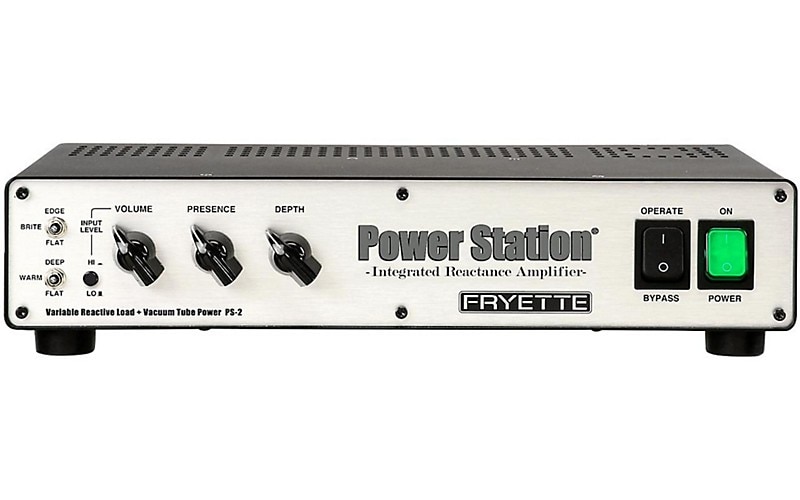Summing up Fryette's latest gear is far more difficult than using it.
The Valvulator GP/DI Direct Recording Amp is a shockingly versatile 1W tube head—and a DI box, a portable preamp and an absolute beast for silent practice and direct recording. The PS-2 Power Station Integrated Reactance Amplifier Version II is an attenuator—and a rack-mountable 50W tube power amp, external FX loop, DI box, impedance leveler and more. And the R112 Recording Speaker Cabinet is a lightweight 1x12 designed for low-volume recording—and sounds absolutely massive with some power behind it.
So, the short version: Put together, this is one hell of a mini stack.
But that doesn't tell the whole story. So, let's explore each of the pieces.
The Versatile Valvulator
The Valvulator GP/DI Recording Amp is designed with recording in mind. Despite its small size (8.75 x 6.15 x 2.75 in.), the back panel hosts 11 jacks for doing the most with the signal and sending it to wherever you want it—a recording interface, mixing board, headphones, speaker cab, or combinations of all of the above.
It offers a headphone output, program input (for playing along with external audio through the headphones), headphone FX loop (with stereo return), aux. input for rack mounting or re-amping, two 1/4 in. and XLR direct outs (one is a buffered dry signal, the other is through the amp, with cab/mic simulation) and amplifier speaker and line outputs for when you want to send your tone into the air.
While cab/mic simulation is becoming common in recent years, the one from the Valvulator direct output is one of the best I've heard. It sounds big and meaty and—most importantly—like the head sounds through a cab. Of course, it doesn't have quite the same deep, open and airy feel as playing through a cab in a room, but that's easily fixed with a good reverb and/or delay in the FX loop, or added after the fact through your preferred DAW. It does, however, have analog dynamics and response that are hard, if not impossible, to replicate digitally.
And with the head's "In/Out" switch to turn the cab/mic simulation off, you have the option of running a raw distortion signal into your DAW to utilize your favorite IR and FX combinations to fine-tune your tone.
When running into an old-fashioned physical cab, it performs beyond what you'd expect from 1W, even with a quartet of dual-triode tubes. Though it's not nearly loud enough for live play, it's more than adequate for home practice and/or recording through a cab. However, it's possible to run direct into a house PA through the line out.
Controlling the Little Beast
The tone-shaping controls on the Valvulator are somewhat unique. It has a standard 3-band EQ and volume control. But that's where the standard knobs end. Instead of multiple channels, it has a three-stage voicing switch—Clean, Deliverance, and Pittbull, which are named after the Fryette amp models from which they borrow the voicing.
Unlike other amps that use different "voices" in place of traditional channels, with each delivering more gain than the one before, and tends to run over the changes in response, these are genuinely different voices. Clean is for full-range sound, Deliverance is designed for crunch, and Pittbull is for modern sounds with plenty of detail.
However, the twin gain knobs really do the brunt of the tone changing, as you can dial in everything from a pristine clean sound to a face-melting lead tone on any of the voice settings. The three voices just change the tonal emphases of what you dial in. Gain 1 dictates the amount of overdrive in the second gain stage, as well as tone shaping, while Gain 2 sets the overdrive of the third gain stage and lets you ramp up the saturation and sustain. And the "More/Less" switch activates (or deactivates) an additional gain stage for some seriously thick and meaty high-octane tones.
It takes a little while to balance things out between the gain controls and the voice settings, but once you get the hang of it, the tonal possibilities are vast and impressive.
Another off-the-beaten-path knob is the one labeled "Dynamics". It sets the signal intensity and sag or compression of the amp. Turned all the way left, your notes each hit relatively the same as the last. But, with some twist to the right, you can hear and feel the notes rise and fall with your picking intensity. And the associated LED acts as a sort of redline for your playing. So, depending on your playing style, it's recommended you calibrate the knob to make the light flash at the peak of your picking attack.
Lastly, the Cab+Mic section of the front panel lets you set the mid-frequency contour of the direct-output sound, as well as the high-frequency emphasis.
Besides the amp's knobs, I was genuinely (and pleasantly) shocked at how well it cleaned up with my guitar's volume controls. I dialed in a thick, saturated metal tone with my Les Paul Studio wide open on the bridge pickup. And then I clicked to the neck pickup with that volume at roughly 1.5, and it was clean, smooth and had dynamics—and still had enough volume to actually play with. It essentially lets you use the guitar as a multi-channel switch.
In all, I love this amp. It sounds great, it's crazy versatile, it fits easily on my desk, it actually sounds good through headphones (a tall order in the amp world), and its recording functionality is incredible.
Oh, and did I mention that it works equally well for bass? From smooth and clean to gritty and mean, my P-Bass sounds awesome through this little thing.
Unfortunately, as I said before, it's not loud enough for live play.
But that's where its friend comes in.
The Potent Power Station
I've been having a hard time labeling the Power Station. I know it's called a "reactance amp," but that doesn't really say what it is or does.
Well, what it is: It's awesome.
And, what it does: So much awesome stuff.
In a nutshell, it's a game-changer that solves a ton of problems guitarists have been trying to work around for decades at great expense. Here are some examples:
Attenuation
Without having a professional, soundproof studio (or a stadium venue), it's pretty much impossible to crank a high-wattage tube amp to its tonal sweet spot without meeting your local law enforcement shortly thereafter. To work around this, guitarists have taken to using power attenuators to bring down the output volume through the speakers while maintaining the tonal characteristics of the amp. But they often color the sound of the amp in unfortunate ways, and are usually equipped with imprecise "notched" knobs that lock at specific wattages.
However, the Power Station will absorb up to 200W of punch from an amp, and let you dial in the desired output with a simple volume knob. And it's your tone, unadulterated.
I've had an old first-generation Peavey Triple XXX 120W head for about 15 years, and it has never been turned up past 3.5 out of 10 on the master volume, even with a full band and no PA. Indoors, I can't get past 1 without incurring the wrath of my neighbors. And at that level, the power section is hardly engaged, and the tone suffers.
But with the Power Station, I was able to pin the volume on the Peavey for the first time ever, and the output was right around the house-appropriate 0.5W–1W mark. Oh, and it sounded amazing!
And the Power Station allows you to set the input and output impedances, so you can match any head to any cab without damaging anything.
Power Amp
It sucks when you find an amp that you really love, but it just doesn't have enough punch to be loud enough for a full band. Whether it's some awesome low-wattage lunchbox or a practice combo with great tone, they're often left at home when it's gig or rehearsal time like the sad younger sibling who couldn't keep up with the big kids.
But the Power Station, besides being a fantastic attenuator, is also an awesome 50W 12AX7- and EL84-loaded tube power amp.
I was able to plug in the plucky little Valvulator 1W head to the Power Station's "Amp Input," run a second cable from one of the two speaker outputs to a cab, and suddenly the "recording amp" was gig-ready.
I also did the same with my Peavey 6505 MH mini head. Even though it has adjustable output from 1W to a gig-worthy 20W, I dropped it down to its lowest output, and it was ready for anything with the Power Station behind it.
You can also use the Power Station to do the heavy lifting when using a preamp pedal or FX processor to have a tube-driven modeling-based rig.
This means that any amp that has a speaker output can be as loud as you'd ever want it to be.
And you have the option of using the Power Station's subtle EQ controls to help fine-tune your tone with switches for high- and low-frequency emphases, as well as presence and depth knobs. But if you'd prefer to bypass those controls, you simply plug into the Line In port instead of the Amp Input on the back panel.
That Line In doubles as an aux. input for a preamp, FX processor, music, etc.—whatever you want to make loud (or quiet) through the Power Station.
FX Loop
Delays, reverbs, choruses and a ton of other FX are happiest doing their work after the preamp. Unfortunately, many amps out there don't have an FX loop built-in to accommodate.
The Power Station once again comes to the rescue with an FX loop that sits in the signal chain right between your amp input and the 50W power amp, so you can properly utilize an EQ boost, various modulation pedals, etc.
Direct Output
When recording at home, it can be tough to play with any real level of volume. Over the years I've often had to work around neighbors, parents, a spouse, a sleeping child, or anyone else who wouldn't appreciate hearing the roughly same riff 40 times. While it's possible to just buy/borrow an amp or modeling rig with a direct out, I've always appreciated recording with the same amp you use live.
With the Power Station's direct out XLR, you never need to plug in a physical cab to get any amp's real tone directly into your DAW to pair with any cab IR you like.
Since I'd already dusted off my old Triple XXX for the attenuation test, I ran an XLR from the back of the Power Station into my M-Audio interface, unplugged the speaker cab and, like magic, my tone was there.
Double the Cabs, Double the Fun
Another issue that guitarists also run into from time to time is that, while it's fun to play with multiple speaker cabs, not all amps have multiple outputs, and not all cabs can daisy chain.
Yes, you guessed it. The Power Station splits your tone into two parallel outputs that total 2, 4, 8 or 16 ohms.
Honestly, at this point, it might be easier to list the things the Power Station doesn't do. But I'm sure that solving world hunger and creating a lasting global peace will be included in a third-generation model.
I can't think of too many guitar or bass players who couldn't use at least some of what the Power Station can do. Whether you need to make your rig louder, quieter, match to a cab, record silently, add some extra EQ functionality, add an FX loop—there's something for everyone in this rack-mountable revelation.
The R112 Recording Cab
I almost forgot about the cab! Well, after all of the features its friends bring to the table, it can be easy to overlook—but you shouldn't.
The R112 is a recording-minded 1x12 loaded with a Fryette AR Seventy-Five speaker, and weighs just 25 lb. It features a semi-open-back design for maximum room projection, and a single 8-ohm 1/4 in. input for ease of use in a home studio.

My first thought when playing through the R112 was that it sounded way too big for a single-speaker cab. In my little office/studio at home, it was absolutely colossal. I've heard 4x12 cabs without that much projection.
And the dynamics at lower volume were fantastic. The AR Seventy-Five has great feel when playing at bedroom levels, and more than enough punch to knock you off your feet with 75W of power handling.
It's solidly built, too. I know it's designed to sit in an air-conditioned studio, but I wouldn't think twice about using this thing in a smoky club on a Friday night.
Since it's essentially a box with a speaker screwed to it, there isn't much in the way of features—except one.
It's a Convertible
As a man, it's my sworn duty to not read directions before using a new toy, tool, major appliance, etc. So, I went through the standard, painstaking process of trying to guess whereabouts the center of the cone was for microphone placement.
After an embarrassing amount of time, I noticed a couple of little cloth tabs on the bottom of the front grille. So, of course, I pulled them. And then I got a cold chill, and started to form an apology letter to Fryette in my head as I heard a ripping sound, and the entire front grille popped out of the R112's front housing.
But, upon further inspection, I spot the Velcro corners on the grille's plywood frame. And, then it became clear—it's removable to make mic placement a breeze.
I love that.
I've been in many a recording session that starts with trying to look through a cloth grille for five minutes to find the center of a speaker, followed by putting tape around that spot for reference. This cuts that process down to a couple of seconds, and makes it even more precise.
Recording
In following the trend of this entire review, it sounds awesome. I put the industry standard Shure SM57 in front of it, and it was great. The sound through my headphones was full-bodied with great dynamics, and the perfect amount of clarity.
It was the same result with every amp in my personal arsenal, as well as the fantastic Valvulator GP/DI head it came with. Obviously, they all have their unique tonal characteristics, but they all sounded big, full and oh so good.
Coda
So, again, how do I sum up these pieces Fryette let me borrow? There's a recording-focused head, an attenuator/power amp, and a recording-focused cab. But they're so much more than that—both individually and used together.
When stacked up, they combine into a 50W, tube-powered, gig-ready mini-stack that I was able to carry by myself with the padded carrying bags Fryette included.
When used separately, you have a do-all, direct-recording amp for guitar and bass; a miracle device that makes any amp as loud or quiet as you want, as well as add direct-out functionality and an FX loop; and a phenomenal bedroom practice/recording cab that's plenty loud enough for real-world live use.
The engineers and designers at Fryette have created, in my opinion, one of the best amps on the market today. They just did it in three parts.
And now I find myself trying to find the right combination of words and chores that will end with my wife giving me the green light to get one of these setups.
Do yourself a favor and check out the Fryette Valvulator GP/DI recording amp, the Power Station reactance amp and/or the R112 recording cab. At least one—or all—of them will make your rig so much better.








































































































































